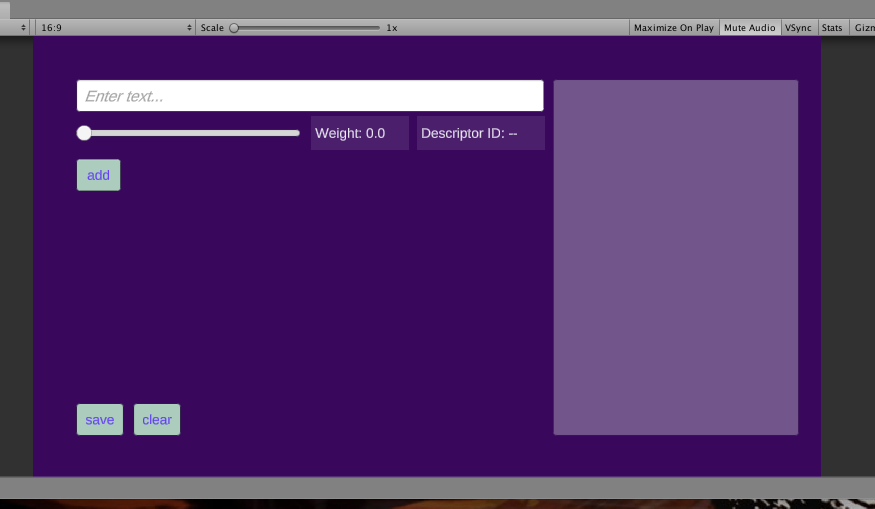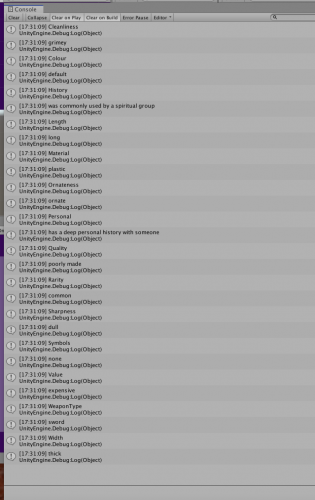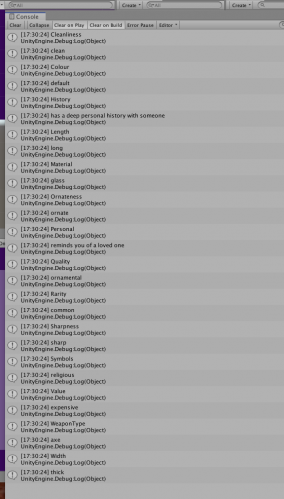
Theme:
I am doing some work at the moment on a series of experiments to begin setting the groundwork for my next game. One of those experiments is focused on interactable/ collectable objects a player character could carry with them in a game (weapons, clothing, gear, trinkets, tools, objects of narrative interest, etc.) In particular I am interested in exploring how a procedurally generated object could be designed to maximise player attachment.
So now I am planning an RPG style game, which will have an inventory system and use procedural generation and I’ve been thinking a lot about how I as a designer can promote and facilitate my players’ attachment to my game world.
Key questions:
- How do objects in a game space facilitate player attachment?
- What characteristics of real world objects do people become attached to?
- Can a game space use these characteristics to generate random objects with the primary goal of facilitating player attachment, above realism, simulation, fidelity, design shortcuts, quantity or other design considerations?
Context:
The best personal example of this problem is in my recent play through of Borderlands 3. The game generates a huge range of weapons which are found in chests and stores in the game. It uses a deep procedural algorithm to achieve variety. About half way through my play through, I found a SMG (Sub-Machine Gun) which when I went to reload it, my character instead threw like a grenade. When it hit the ground, it made a loud “OUCH!” sound and immediately exploded into a bunch of smaller versions of itself which all when they hit the ground, made their own higher pitch “OUCH!” sound. This caught me totally off guard and I found it hilarious. It immediately became my favourite gun in the game. An hour or so later, my character had increased a few levels, gained some new abilities and found an increasing number of guns which just did more damage than my ridiculous favourite and I begrudgingly put it into storage as it became impractical to use such an underpowered weapon. I finished the game but I never could shake the feeling that the game had shot itself in the foot by generating this object which I had become attached to, before quickly making it obsolete by the same method in which it was created.
I’ve loved RPG’s for a long time, particularly tabletop RPG’s like Dungeons & Dragons and I have been a part of many D&D circumstances where players became deeply attached to their characters' possessions. A recent example was during the MAGI D&D campaign last year wherein Homie’s character Thia discovered an expensive bright steel spear with an engraved ebony shaft and a red tassle and became instantly obsessed with buying it. Since she was a monk and had little concern with material possessions usually, this was an interesting turn for the character and it became an interesting aspect of her personality for the rest of the campaign. In this case, it was the aesthetic appeal of the object ( I had a feeling Homie/ Thia would like it), as well as its implied power and rarity in the game world which initially drew the character in and then the fact she had to work for many sessions to collect enough money to pay for it. It became her preferred weapon and she even bought new clothes to match it’s aesthetic.
Method:
- Identify a range of descriptors people use to explain their attachment to important objects via interviews
- Categorise these descriptors, add and remove categories where necessary
- Narrow the range of objects to a simple test set - bladed weapons
- Create a text based random object generator in Unity (see photos)
- Next steps - Generate a number of objects at random and survey people about their levels of interest in these objects considering an appropriate context - in this case something like ‘post-apocalyptic wasteland’ or ‘fantasy dungeon’
Reflection:
I have a random weapon generator working in code at this stage. I’ve also managed to create a simple interface to start managing the generated objects. At this stage, the interface is incomplete and the code is not ‘hooked up’ to it but it does generate random weapons in the console (see images) These weapons are currently limited to sword, dagger & axe and have short lists of characteristics from which it randomly selects.
I am happy with the output, although it needs a functioning interface. I learned a lot during this process about procedural generation and particularly how to manage JSON database language in Unity, which I use to output the objects in a couple of files.
The next step will be to finish the interface/ generator and then conduct a series of tests to evaluate the items which are generated. After that, I will refine the system and test it again over a few iterations. I would like to add probabilities to the values in the categories and a few other procedural generation options. Beyond this experiment, procedurally generated objects could have visual representations and be given a series of parameters which allow them to be used in a game.
About This Work
By Nick Margerison
Email Nick Margerison
Published On: 10/03/2020


